
From left to right: Tammam Azzam’s Syrian Museum: Gustav Klimt’s The Kiss (Freedom Graffiti), archival print, 2013; Sara Shamma’s Meat, oil and acrylic on canvas, 2014; Kevork Mourad’s The Last Prayer, acrylic on paper, 2014.
The three artists participating in this interview left their homes in Syria behind, and each employs a distinct aesthetic to address the crises facing their nation. In this extended interview we find answers to the question: What is life like as a refugee and artist?
Lindsey Davis (LD): What was the experience of leaving your home like? What do you miss most about the Syria you remember?
Tammam Azzam (TA): I left Syria four years, four months, and two days ago. Life as I knew it had ended. The revolution made me another person in life and in art.
My family left with nothing, just our suitcases; we started a new life from zero. No materials, no studio, nothing. When people ask me what I miss most about home, I tell them I miss my studio above all; it was my sanctuary, especially during my military service. It’s gone now, just a memory … but I am relieved to be in a safe place where I continue with my work, and I know that I am among the lucky ones. Slowly we have begun to rebuild our lives here. I now work from my studio attached to Ayyam Gallery in Dubai. It is safe and secure, but it is not permanent, it’s not home …
Sara Shamma (SS): I resisted leaving for almost two years; many of my friends left Damascus just a few months after the crisis began. I was always hoping that the situation would improve, but instead it deteriorated. Many car bombings took place in Damascus, security became very bad, checkpoints were everywhere, and the route that used to take ten minutes by car from my house to my studio became a two-hour drive. I resisted leaving until one day, when a car bomb exploded close to my house, at the end of 2012. I was alone with my two young children; my husband was in his office. This was the peak of the fear and anxiety that had accumulated over two years. I thought that the security and mental health of my children should come first, so we made the decision to move to Lebanon, and we did it in less than a week. My husband continues living in Syria because of his business, but he comes every weekend to visit us in Lebanon, and the trip takes him five hours. It has been three years that we have been living this way.
I would never forget Syria, but the Syria that I remember before the crisis was totally different than today’s. It was really nice, very safe; I used to drive my car alone at two o’clock in the morning without any fear. There wasn’t any tension between religions or sects; it was a real multicultural, multi-religion, and multiethnic country. Also, just before the crisis, Syria was developing economically very quickly, so many of my friends who used to live abroad—in the United States, Canada, Europe, and the Gulf states—came back to Syria between 2007 and 2011, purchased flats, and established businesses (unfortunately they all left again). This is the Syria that I remember and miss.
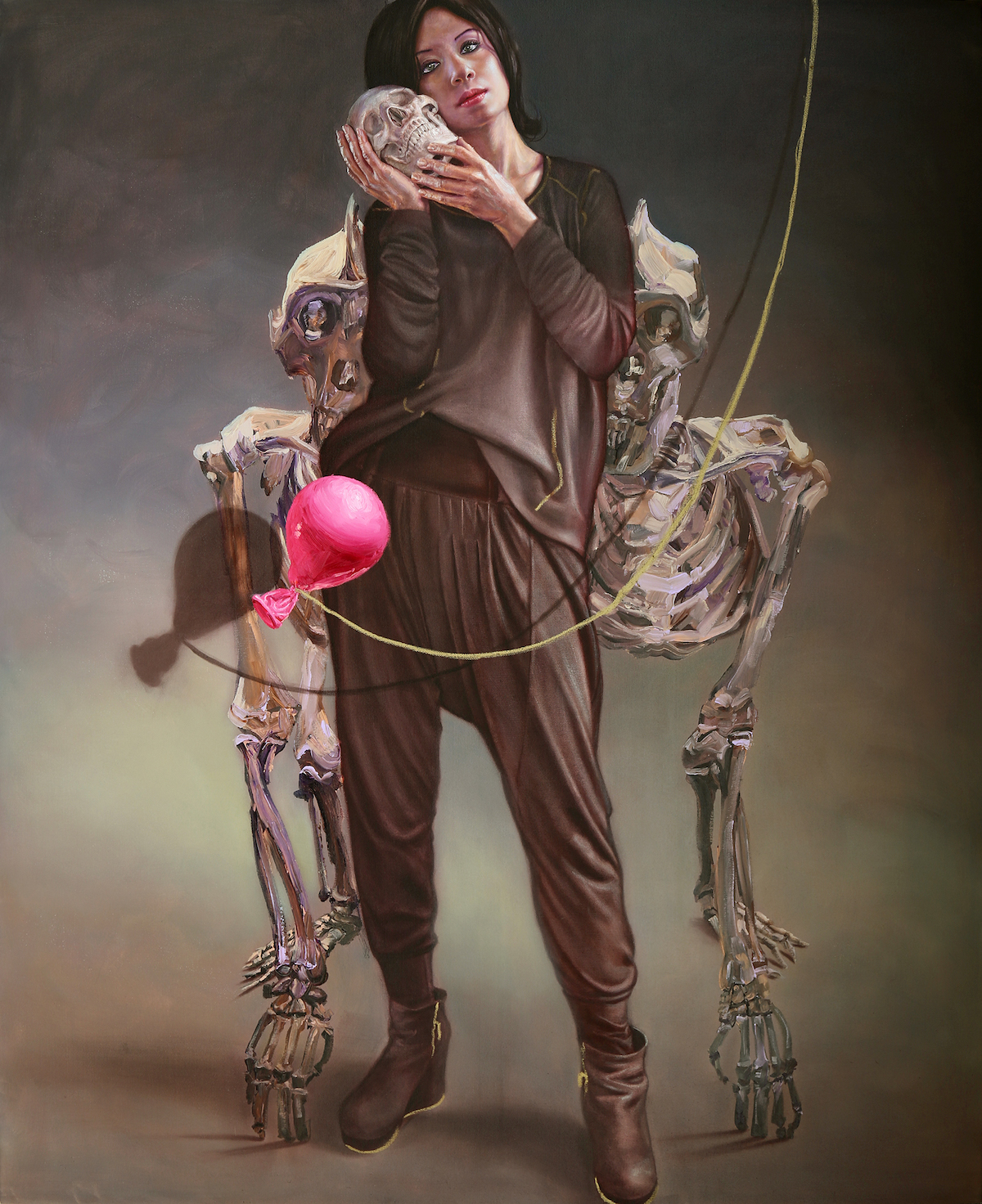
Sara Shamma. Self portrait, 2015. Oil and acrylic on canvas, 200 x 250cm. Courtesy of the artist.
Kevork Mourad (KM): I left Syria to study in Armenia in 1991 with the mindset that I would return to Syria after getting my master’s degree. But by the end of my education, I had decided that I would go to Europe or the United States, and in 1998 I was sponsored by an American arts patron to come to the US.
I will always consider Syria a home. It’s the origin of my memories and my link to the cultures that defined me. America is the place in which I have evolved as an artist and where I have created a family, and so it is my truest home now.
What I miss most about Syria are the beautiful neighborhoods in which different ethnicities coexisted, the way friends got together without scheduling anything, the food, the spontaneous gatherings, the slowness of time that characterizes the culture there and is the opposite of here.
LD: What did it first feel like to live in a country that wasn’t your own? How has the feeling changed over the years as you acclimated to a new environment? And how have both affected your artistic process?
TA: When I left Damascus, I was working on a series that I had to abandon as it was no longer relevant; it was made up of stories about people from my city. That was extremely hard, and it took me a while to recover. My work has changed beyond recognition since then. In Syria, I was a primarily a painter; when I left, I became known for my graphic art. At first this led to criticism, but as my work has developed, people have gotten used to it. I have also had a fair bit of my work featured in the media in relation to the ongoing crisis in my country, so I am particularly proud of that.
SS: My mother is Lebanese, and we moved to her hometown—a beautiful small town in the hills where I have a lot of relatives and where I always visited during my childhood—so I felt at home. Maybe I am luckier than other Syrians because I think, after three years, that Lebanon is a great country and the Lebanese are really nice people. I really believe that the relation between Syrians and Lebanese, despite some problems between them, is the relation between two family members in the same home: at the end of the day, they are brothers.
I think immigrants, refugees, or any people who are obliged to live in a different country should take advantage of their new situation to improve themselves, to learn new skills to become better, so when they return home they can bring something good to their country. There is always something positive in visiting or living in another country, and in Lebanon we can learn a lot.
KM: At first, [I experienced] a cultural shock. For the longest time, I felt that I didn’t fit in and was thinking of returning to Syria, until I discovered New York and realized it was a place to become an artist—that people in this country are willing to hear the individual stories from people around the world. I started digging into my roots, and I became much closer to my two cultures, Armenian and Syrian, once I was in the US. I was happier to acknowledge my heritage and felt stronger as an artist here.
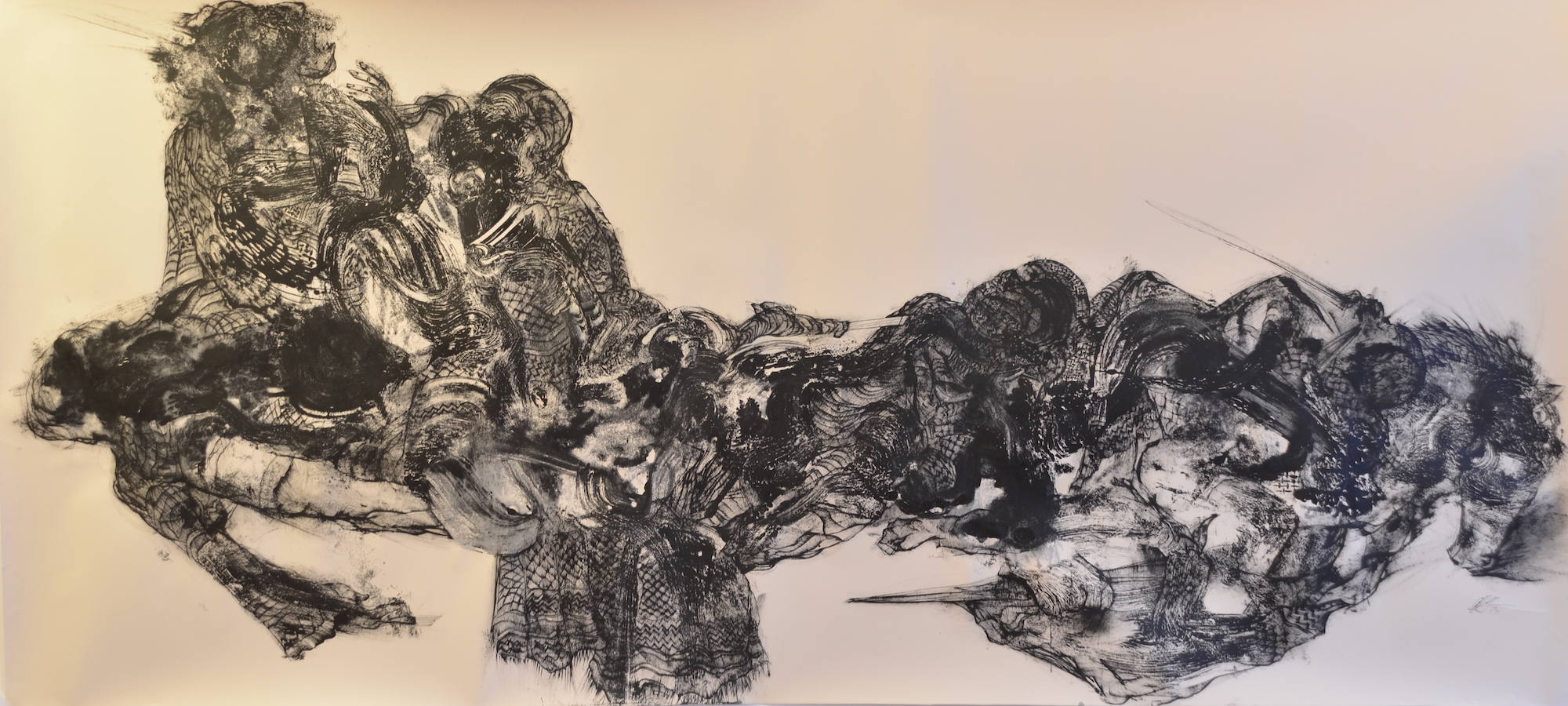
Kevork Mourad. The Last Voice, 2013. Acrylic on paper, 96 x 48 inches. Courtesy of the artist.
LD: Do you feel a sense of responsibility to address the crisis in Syria through your art? Or is it more of an overwhelming need to express the situation’s urgency to those unaffected by the war?
TA: The only thing that I can do as an artist is to try to make evocative and thoughtful images relating to what I have witnessed, in order to give the world a better understanding of the situation.
One work in particular seems to have resonated with people. I had posted the work Freedom Graffiti online, from the series Syrian Museum, and then left my house; it went viral. When I came back a few hours later, I was bombarded on every social network by journalists and by people I didn’t know.
The work features a famous painting by Klimt. I chose it as an icon of love, a way of looking for the stories of love behind this wall that was completely obliterated by the machinery of war. In Syria, the spaces that once held windows or doors must have borne witness to thousands of stories behind them; now, they are just voids.
Goya created a work to immortalize the killing of hundreds of innocent Spanish citizens on May 3, 1808.
But how many May 3rds do we have in Syria today?
The Syrian Museum series was my attempt to highlight [a condition in which] the whole world could be interested in art and blindly neglect the fact that two hundred people were killed every day in Syria, at the time. Other works in the series feature famous artworks by Warhol, Van Gogh, da Vinci, Goya, Dali, Matisse, Gauguin, Munch, and Klimt. From one perspective, the series’ emphasis on Western art history conveys a fact—that we are all citizens of the same world—and equality in all things, including culture, is important to me. From another perspective, I felt that these instantly recognizable images of European masterworks could be borrowed to draw attention to the tragedy of Syria. Goya created a work to immortalize the killing of hundreds of innocent Spanish citizens on May 3, 1808. But how many May 3rds do we have in Syria today?
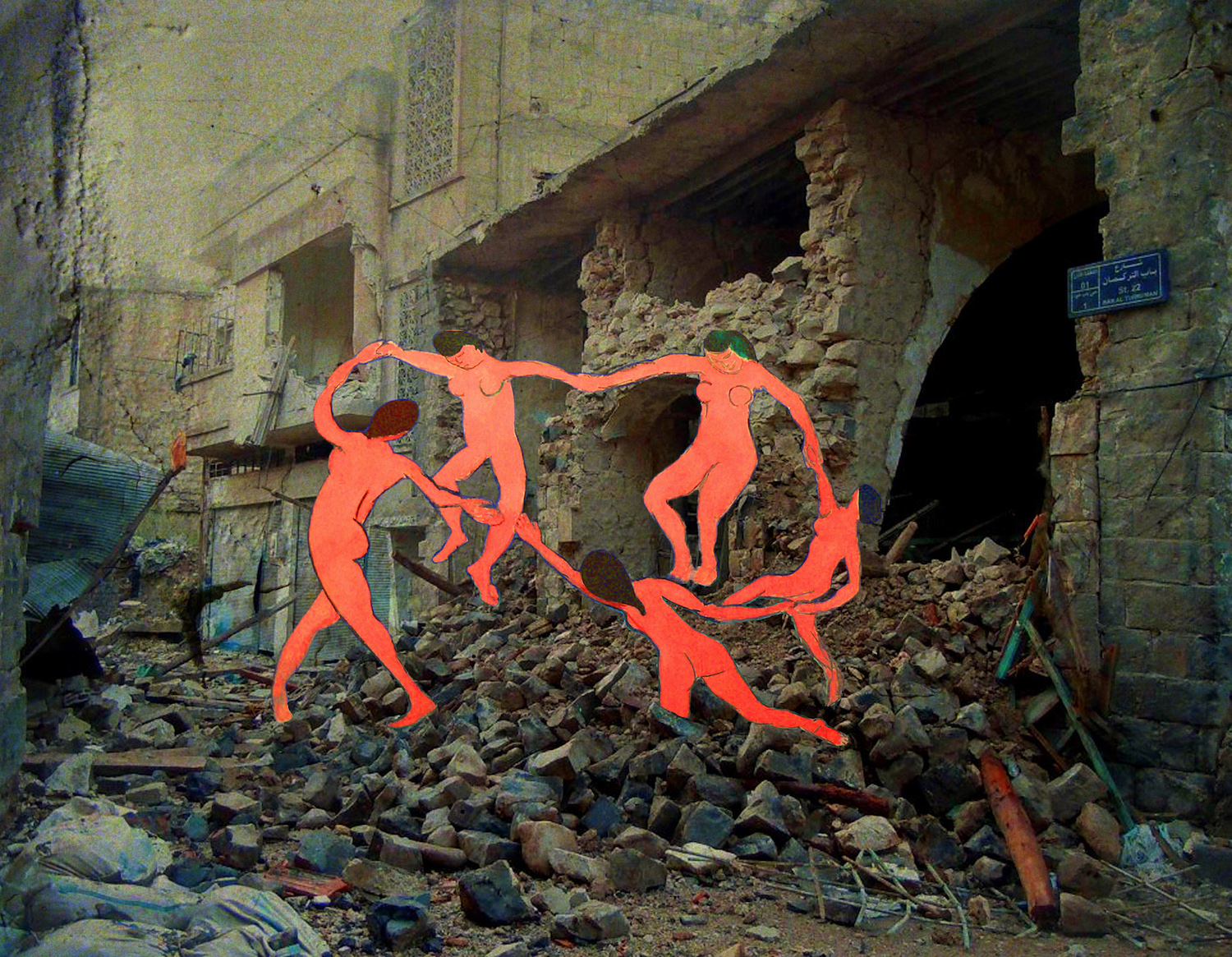
Tammam Azzam. Syrian Museum: Matisse’s La Danse, 2012. Archival print on canvas, 45 X 60 cm. Courtesy of the artist and Ayyam Gallery.
SS: People tend to forget their pains, such as wars. This is good [for easing individual suffering], but forgetting can lead to committing the same mistakes that caused these pains. Art can constantly remind us of the pain and the mistakes, so that people do not fall into the same errors again. One of the ways we forget the atrocities of war is by transforming them into journalistic facts that vanish the next day to give place to new journalistic facts. Some art is journalistic, but I think real art should bring these horrors back to our consciousness by connecting with the viewer on a personal level and by moving his imagination. Art should push the viewer to formulate his own knowledge about the war rather than gathering information from mass media. I think there is a crucial difference between knowledge and the accumulation of information; I think knowledge is an essential step toward dealing with our problems in a peaceful way.
KM: I am addressing the crisis as a Syrian-Armenian, as a descendant of people who were saved by the Syrian people during the genocide of 1915 by being welcomed into, and nurtured by, Syrian society. I have no choice but to express in my works the need for unity and the fact that human suffering is the same wherever you go.
Right now, all of the ethnic groups in Syria are going through the same thing. I want people in the West to relate to the Syrian people as a group who are suffering together, rather than as people splintered by religious or ethnic differences. I feel immense gratitude toward the country in which I was born and immeasurable sadness about what is happening to it, and there is no way I cannot devote most of my art to what is going on now.
LD: What are your feelings toward Daesh/ISIS/ISIL, and how do those feelings surface in your artworks?
TA: I have made many artworks addressing the subject of the myriad of difficulties facing my country. All I can say to you is that people are truly desperate; they feel like they have nothing to lose. They would rather take the risk of drowning in the Mediterranean or living in a miserable refugee camp than to stay and suffer under the dual persecution of Assad’s forces and Daesh. Most have no other recourse; they just want to stay alive.
SS: This is an international problem now; it represents the ugliness and violence of fanatic beliefs. It is a situation that doesn’t have any excuse [for being], and I think all contemporary art will be affected in one way or another by this unfortunate circumstance.
KM: Throughout history, there have always been barbarians bent on destroying culture and civilization (as with the burning of the library of Alexandria, for example). Groups like ISIS/ISIL are shape shifters; they take on a new identity and seek to cause havoc according to where they find power.
The way I feel we can fight against them is to create, with other Syrian artists around the world, a strong cultural presence outside Syria—to be linked together, to document what is happening, what is being lost. As soon as ISIS disappears, we need to bring back to our country as much of what was lost as we can.
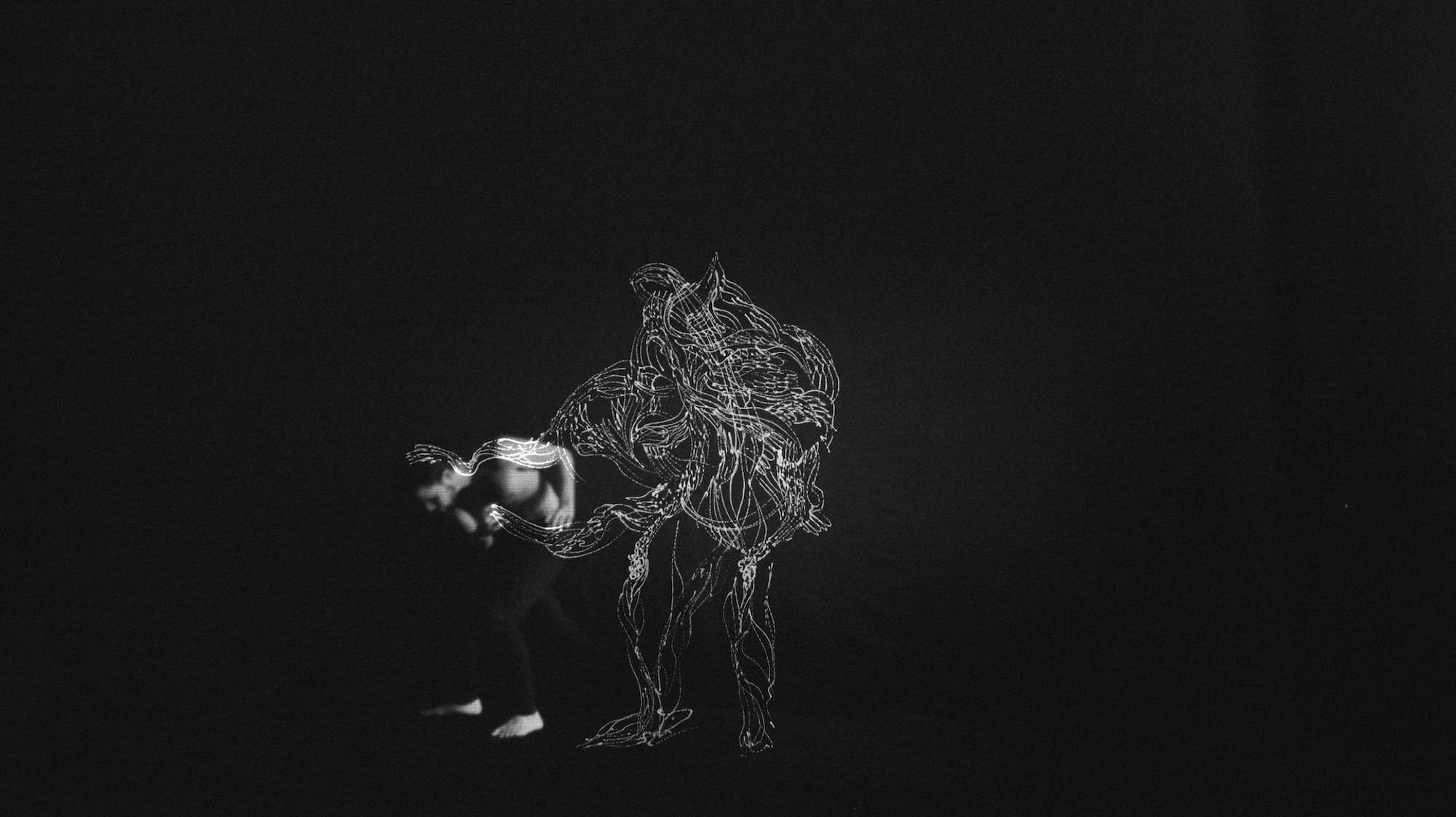
Kevork Mourad. The Barbed Wire, 2015. Video still. Courtesy of the artist.
LD: How well or poorly do you feel the international community is handling the crisis in your home country? What do you want people to know about how Syria has changed since the civil war began?
TA: We don’t want to be a burden; we just need urgent help from the international community. We are human beings in a desperate situation.
SS: It is not just a Syrian crisis anymore; it has become an international issue, a world danger that the world doesn’t take seriously yet. This [fanaticism] is spreading everywhere, and I think that the solution cannot be waging more wars; politicians should think about new solutions that are not violent. I want people to know that Syria has changed a lot; we lost a lot, and the world is also changing and losing. New solutions should be created for this conflict and all the ones related to it.
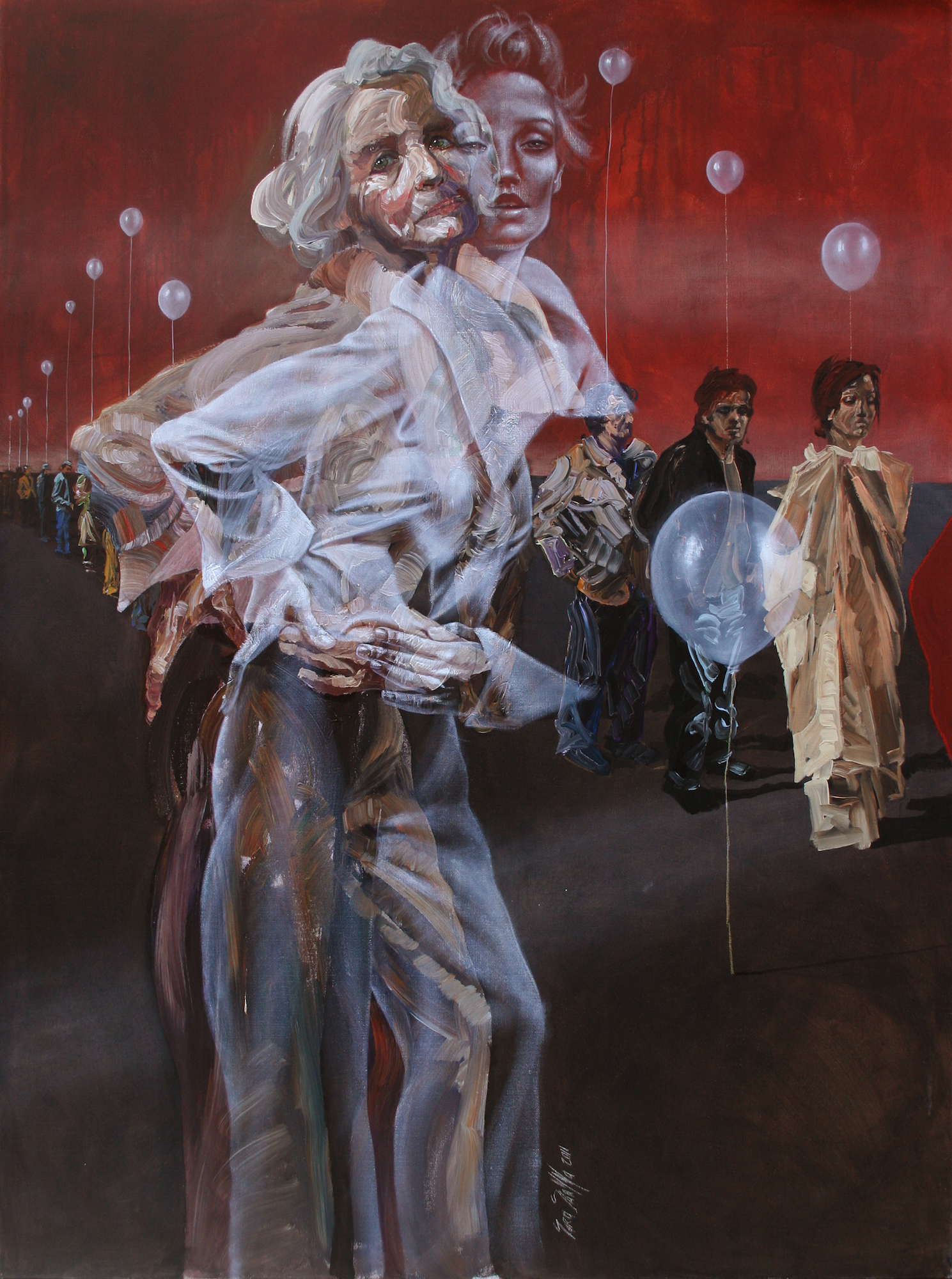
Sara Shamma. Q6, 2011. Oil on canvas, 150 x 200 cm. Courtesy of the artist.
KM: I feel the international community is looking at the crisis from a position that is too broad and distant, instead of portraying and explaining the crisis in the country from the inside. Support is falling into the wrong hands; people are not receiving what they need to escape or end the conflict.
Since the war started, Syrian society has become fragmented into groups whereas before the war, the population was more cohesive. There are divides now where there were none.
LD: What do you ultimately hope will happen in Syria? Would you consider moving back if peace returned?
TA: Personally I cannot see a future for myself in Syria; I just want to move forward with my life … wherever it may take me.
SS: I hope the war will stop, but it is not enough; we need to create the conditions for a lasting peace, not only in Syria but also in the whole region. Lasting peace can be achieved only with tolerance, with laicism, with a minimum of economic justice, and with a lot of forgiving.
I will go back to Syria when peace returns. I hope it will be soon.
KM: I hope that the moderate Syrian thinkers from abroad and within Syria will have a chance to create a secular Syria. I want this war to end quickly and for democracy to finally come to my native country, with freedom of speech and uncensored artistic expression.
I left Syria a long time ago, and my life with my American family is solidly established in New York. But I’ve always dreamed of a studio in Damascus because the place inspires me almost more than any other.
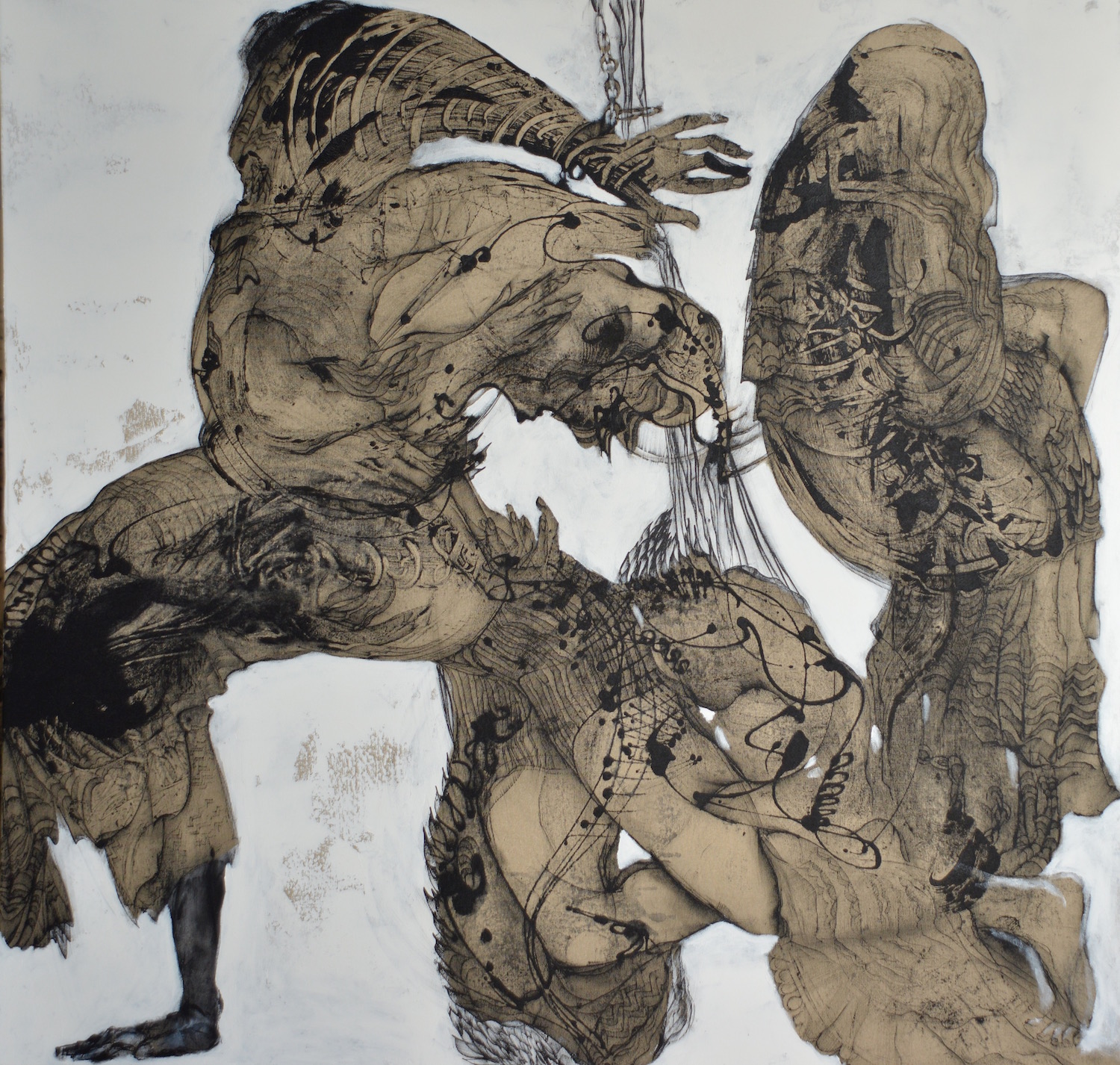
Kevork Mourad. Downward, 2013. Acrylic on paper. Courtesy of the artist.
LD: To what extent do you incorporate anxiety and unease in your works? Do you view this discomfort as necessary in order to confront viewers about the horrific realities your work addresses?
TA: I think the nature of my recent artwork is certainly uncomfortable and confrontational. The six works in my Bon Voyage series feature a building destroyed by war—floating over the individual cities of New York, London, Damascus, Geneva, Paris, and Beirut—and attached to a bunch of colorful balloons. On one level, the works are about the idea of dreaming of being somewhere else, of being able to float away to a peaceful time. On another level, the works highlight the roles that these cities have played in the recent history of Syria and the wider Arab world.
Bon Voyage, New York illustrates the many different emotions and consequences experienced by different peoples around the world as a result of 9/11. Clearly, that event was one of the most dramatic and tragic events of our lifetime, but the lack of empathy and assertive action for the myriad of other acts of terrorism and humanitarian disasters around the world troubles me. Empathy should not be limited to [events occurring in] the First World.
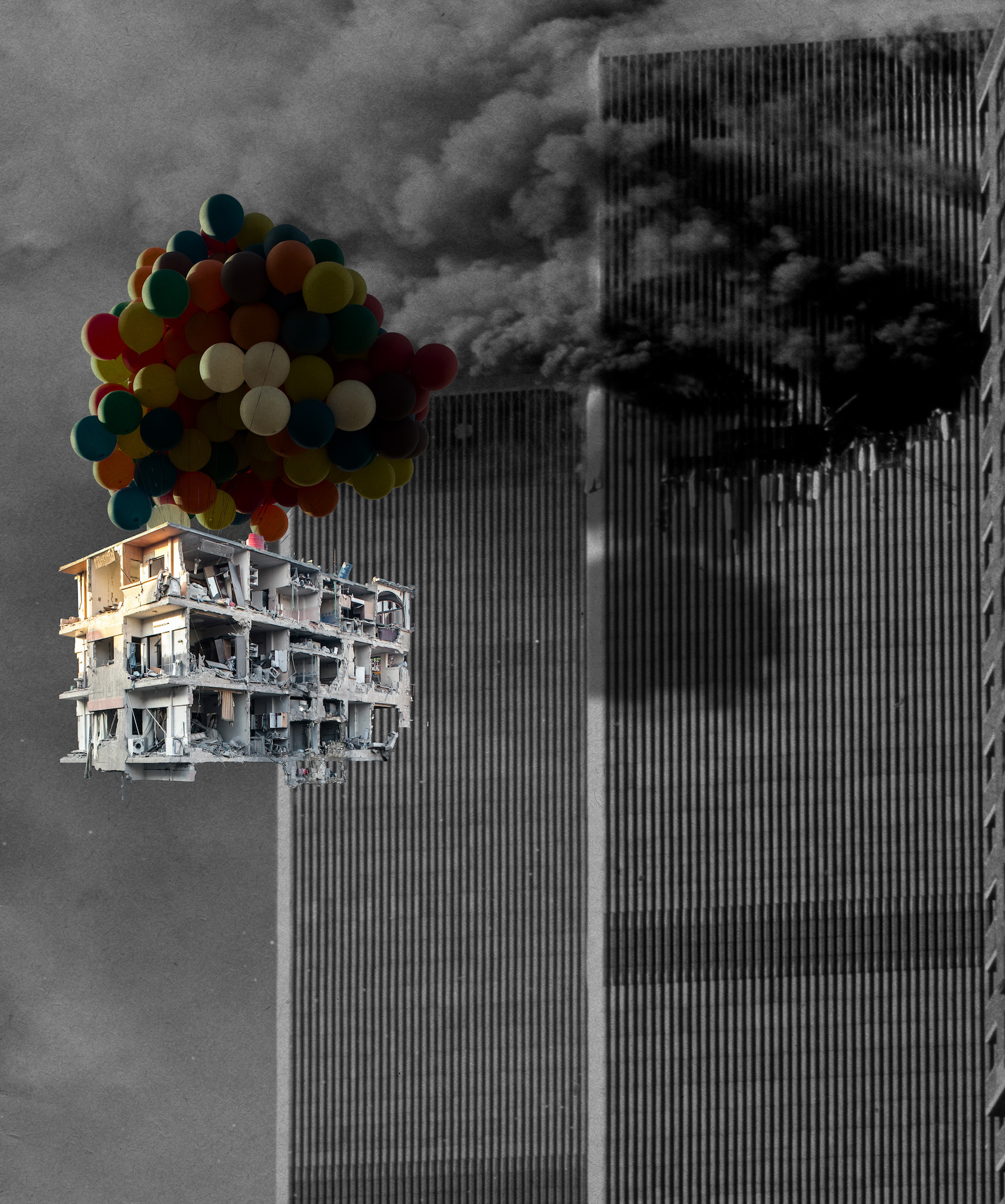
Tammam Azzam. Bon Voyage: New York, 2013. C-Print Diasec Mounting Edition of 5+3AP, 120 X 100 cm. Courtesy of the artist and Ayyam Gallery.
SS: I think there are two tendencies in art born of conflict: one fuels the struggle by pointing fingers and judging, and another shows the conflict’s negativity in a sensitive, humanitarian way that works toward the extinction of violence. The first raises emotions of anger, hate, and desire for revenge while the second provokes reflection, consideration, and understanding.
When art is political, it is like a newspaper that is useful today but is worthless tomorrow; art, even political art, should have a deeper dimension and carry [a noble] sensibility. It should touch and move the spectator, continuously. Art should be timeless.
KM: In the past four years, I’ve felt that everything could collapse at any second. While paintings are fixed images, I’ve wanted to create paintings [of places] that suggest to the viewer that this could be the last moment of that place’s existence. My paintings often depict movement—the subjects are rarely still but rather in the middle of a gesture, and the lines often give the impression of movement from one part of the canvas to another—because I want the viewer to think of what comes after whatever is depicted, and hopefully the viewer will contribute in helping to end this crisis.
My work is not comprised solely of paintings; I create video art and live performance pieces, and I have collaborated with musicians and with writers and actors. The tenor of my work is often political; I often seek to explore themes and subjects that I find troubling or vital.
LD: Do you believe art can produce or instigate significant change in the world? What do you think it will take for Syria to reach peace, and how do you feel art can help make this a reality?
SS: Art usually addresses public opinion, [with the idea] that the public puts pressure on the decision makers, the politicians in this case, to act in a certain way. Why doesn’t art try to address the decision makers directly?
Art needs to encourage the decision makers, the politicians, to set their imaginations free, so they can think about new nonviolent solutions to the conflicts. When an artist starts an artwork, in order to create something new, she needs to put away her preconceived notions, stereotypes, things learned in university, influences from others (artists and non-artists), and the ways she expresses herself. Only then can she be completely free to create something new. The same should apply to the politician: he should handle every problem without prejudices, without a preset plan. He needs to give his imagination maximum space to move, to be able to create new solutions.
Syria and the region need new creative solutions that are not violent.
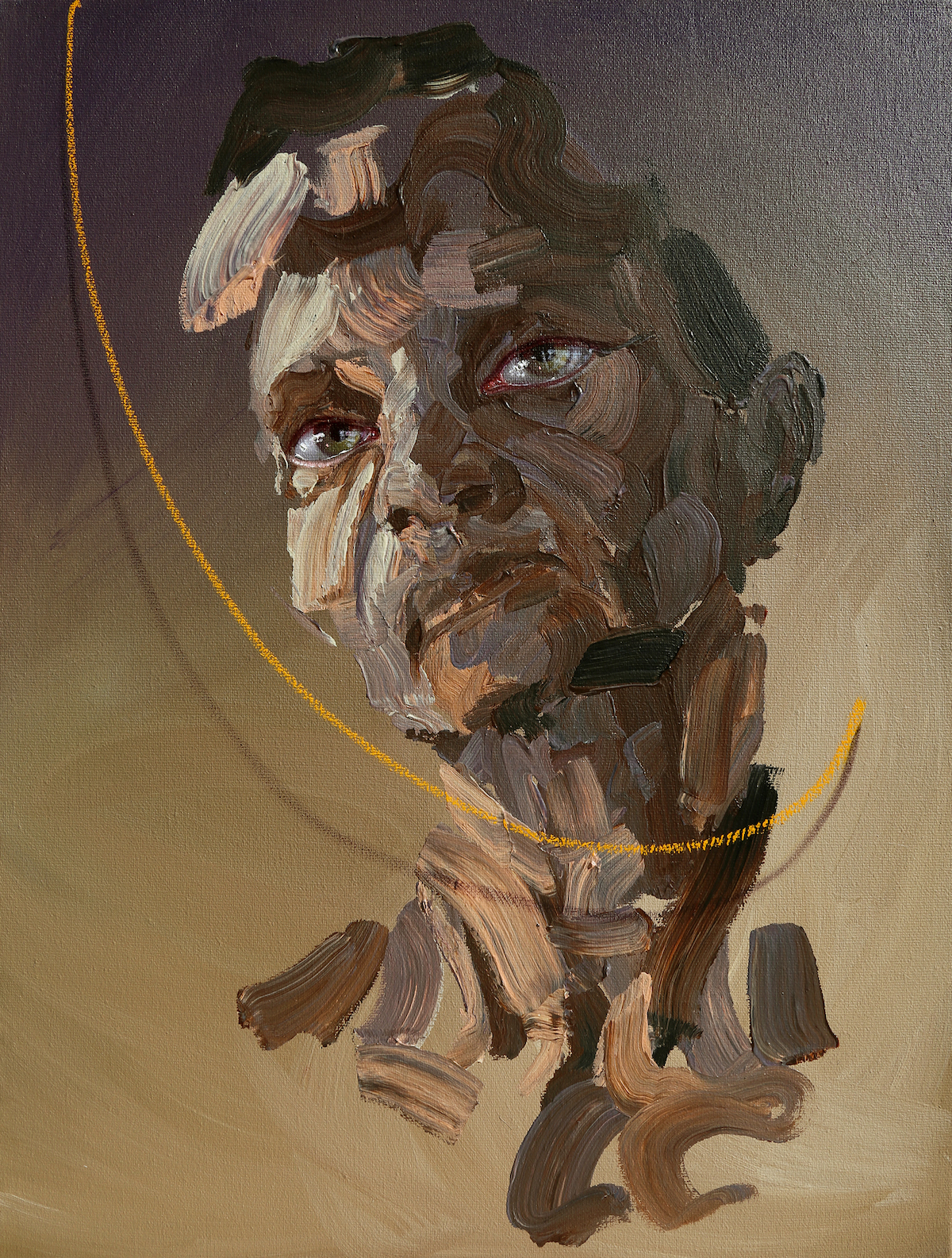
Sara Shamma. Incognito 3, 2015. Oil and acrylic on canvas, 60 x 80 cm. Courtesy of the artist.
KM: If thousands of Syrian artists come together to express their perspectives about Syria, connected through social media, they will provide a clearer image about the fabric of Syrian society than what we see in the news media. It will bring us a step closer to peace. Growing up, we functioned together the way that artists are working together today—with harmony and a drive to learn from each other.
LD: What do you think of the work being done by fellow Syrian artists, including the other interviewees? Do you feel a sense of community with artists whose work arises from a similar culture and experience?
TA: I do feel that I am part of a community of Syrian artists, along with others like Sara Shamma and Kevork Mourad. All we can do is document our people’s struggle; if we can create a dialogue and raise awareness, we have done our job.
SS: Their work is nice. I feel a sense of community with all artists of the world, not only those who share experiences with me. At the same time, though, I don’t feel I fit into any category.
KM: I know Tammam Azzam personally, and I love the way he thinks, the way he works. He is constantly inventing himself. I think he’s brilliant. I don’t know much about Sara Shamma’s work, but I know she does realistic portraiture. She’s a highly skilled artist. I definitely feel a sense of community with artists whose work arises from a similar culture and experience.
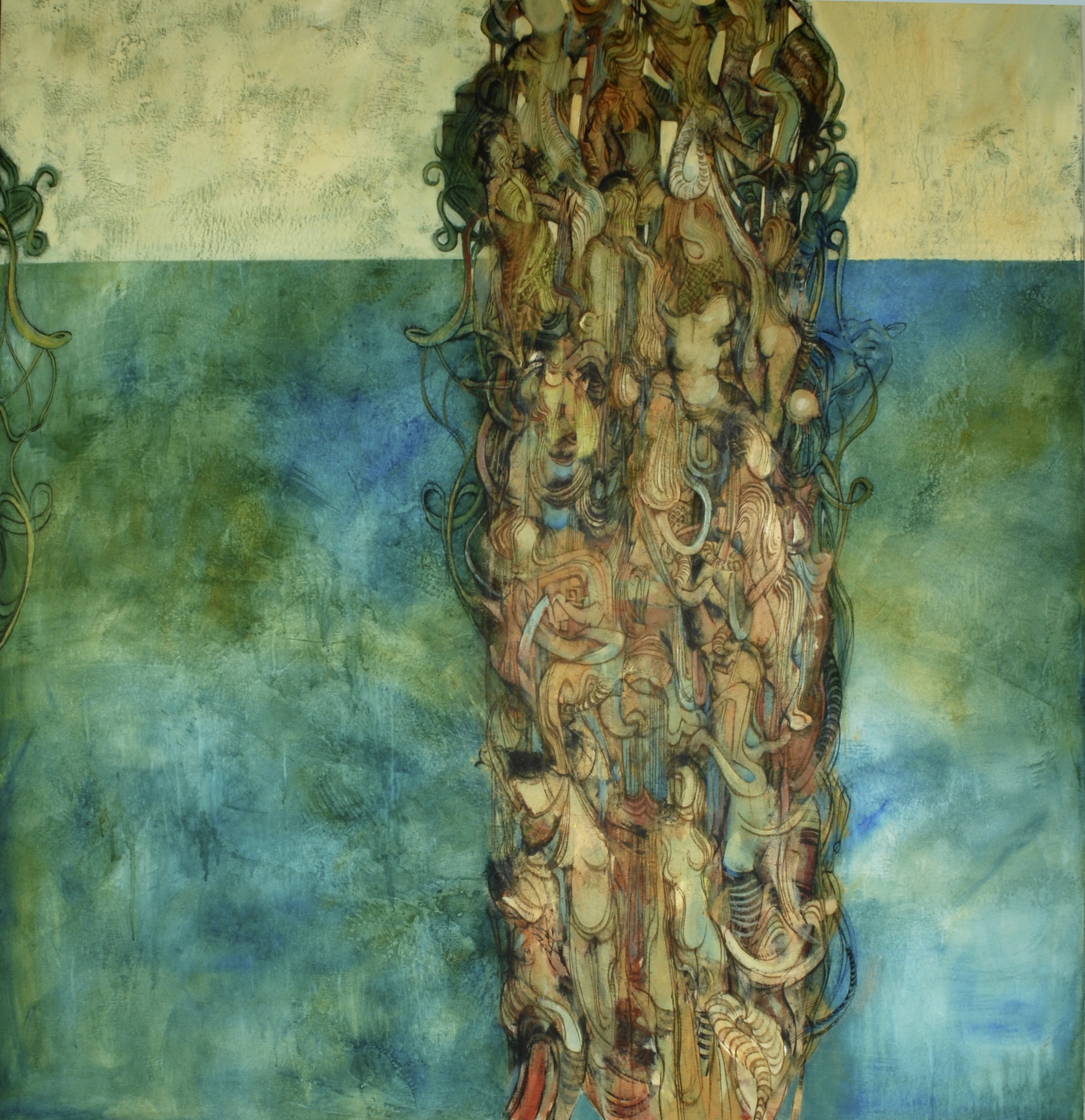
Kevork Mourad. Words for All, 2009. Acrylic on canvas, 48 x 48 in. Courtesy of the artist.
LD: What does the word movement mean to you and your artistic process?
TA: My upcoming solo show, The Road, very much addresses the notion of movement. My new paintings, in the series Storeys, place the viewer at the beginnings of still and empty roads, ones that have no set direction or destination, roads with endless trajectories and countless unseen obstacles along the way.
We as Syrians are all now preoccupied by movement: movement to a safer place, movement forward with our lives.
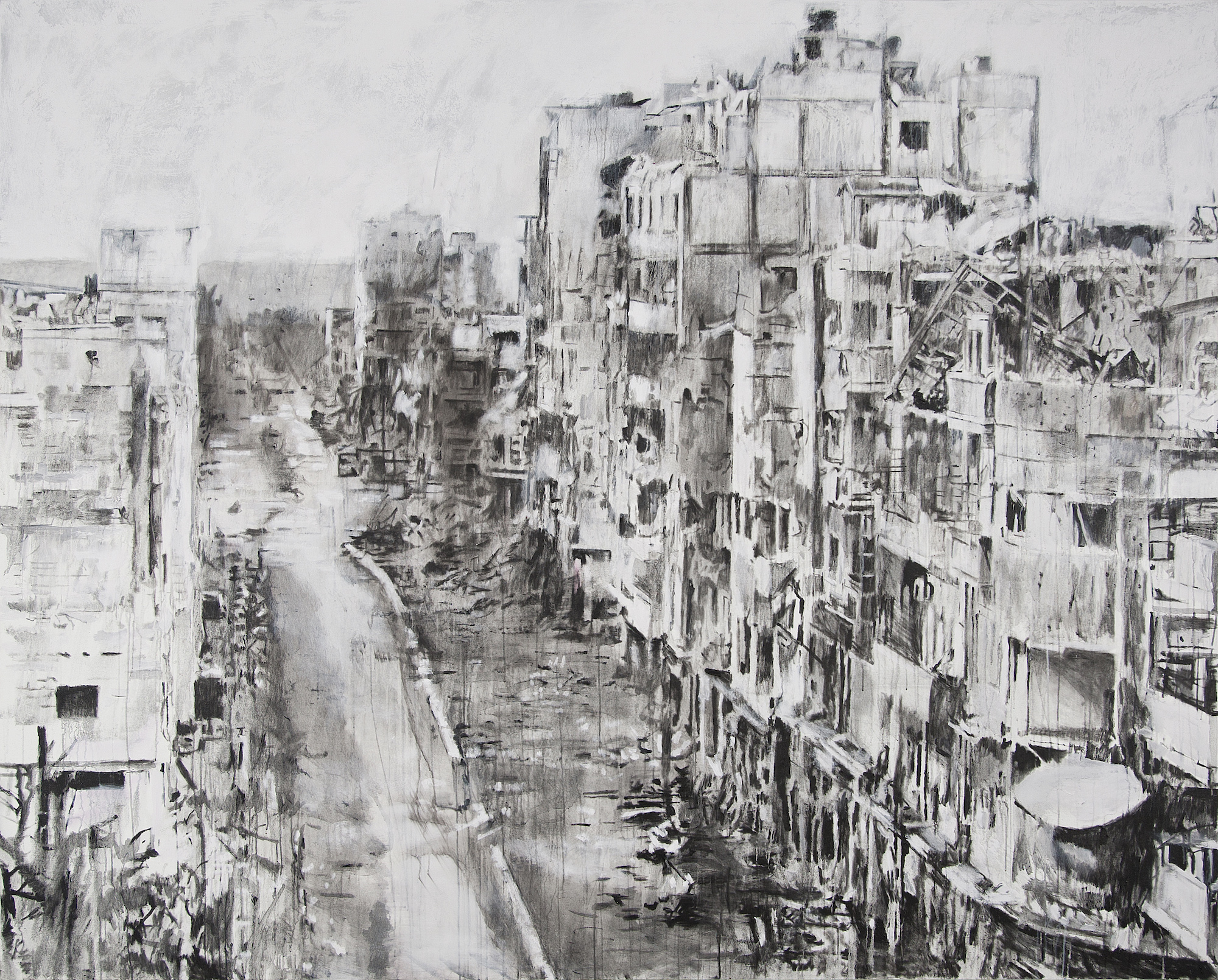
Tammam Azzam. Storeys Series, 2015. Acrylic on canvas, 200 x 250 cm. Courtesy of the artist and Ayyam Gallery.
SS: The gestural movement within the artwork is an essential element in my paintings. I work a lot with transparent colors, and when I repeat a body part—one after another, using transparent colors, with a small distance between them—the person appears as if in motion, with a moving hand, a changing facial expression, as if dancing …
With transparency in the painting, you feel the air; you can enter into the painting. I think movement is life.
Considering the word movement in a more interventional sense, as in a social or political movement, I think important art is a social movement of its own.
KM: Movement, for me, means that you, as a viewer, are seeing something that comes before the next crucial moment. There are two aspects to movement: one is gestural and one is related to meaning. I love seeing art in which the gesture, the form, is expressed with minimal, masterful movement—art in which movement is expressed in the expert quality of the line. The other part of movement is the mystery of what comes next. Though painting is not a linear art, I like the idea of the image pointing or pulling the viewer toward the next idea.
Tammam Azzam’s solo exhibition The Road is on view at The Ayyam Gallery Dubai from January 18th to March 3rd, 2016.
Sara Shamma is currently at work on an upcoming collective art project in London involving artists and politicians called “Positive Peace.”
Kevork Mourad is performing the audio-visual piece Home Within, a collaboration with Syrian composer and clarinetist Kinan Azmeh, in New York on January 22nd and in Philadelphia on January 24th.




Pingback: Art & Pancakes, January 31st, 2016 | Bay Area Art Grind